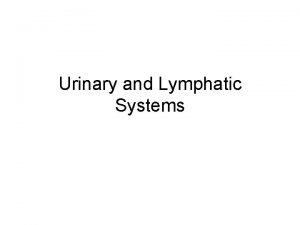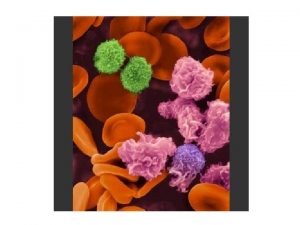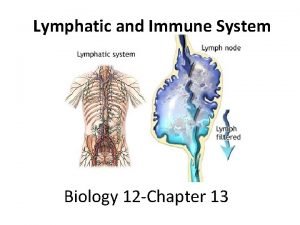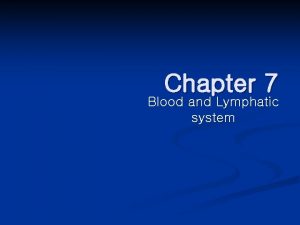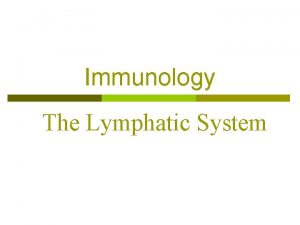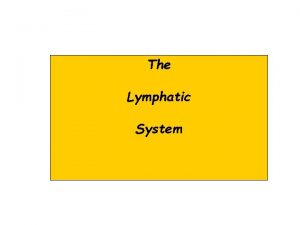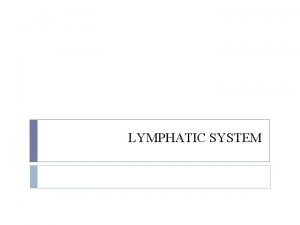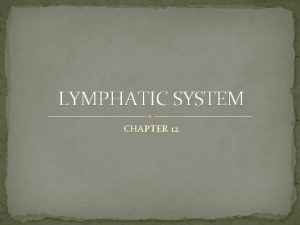Chapter 24 Lymphatic System Function of Lymphatic System

















- Slides: 17

Chapter 24 Lymphatic System

Function of Lymphatic System • Transport excess interstitial fluid, called lymph in lymphatic system • interstitial fluid is fluid around cells; extracellular fluid includes interstitial fluid and blood plasma • Maintain fluid homeostasis • Check lymph foreign material • Initiate immune response

Fig. 24. 2 Structure of Lymphatic System • Lymph vessels absorb excess fluid around capillary beds • arterial end of capillary bed forces fluid into interstitial space around cells • venous end of capillary bed reabsorbs most but not all fluid • Lymph vessels transport lipids and lipidsoluble vitamins from gastrointestinal tract around body Interstitial fluid Capillary bed Lymphatic capillaries Tissue cells Arteriole (a) Capillary bed and lymphatic capillaries Venule

Fig. 24. 2 Structure of Lymphatic System Interstitial fluid Capillary bed Venule Anchoring filament Lymphatic capillaries Lymph Tissue cells Opening Arteriole Interstitial fluid Endothelium of lymphatic capillary (a) Capillary bed and lymphatic capillaries (b) Lymphatic capillary • Lymphatic capillaries are closed-end vessels interspersed through capillary beds (except in red bone marrow and CNS) • Larger diameter than blood capillaries; similar structure • Held in place by anchoring filaments

Fig. 24. 3 Structure of Lymphatic System (a) Lymphatic vessel, longitudinal section Overlapping endothelial cells Lymph (b) Lymphatic vessel, cross section Valve open (lymph flows forward) Valve closed (backflow of lymph is prevented) Direction of lymph flow LM 100 x • Lymphatic capillaries merge into lymphatic vessels • Vessels have valves (like veins); prevents pooling of lymph • Lymph from GI tract is white because of fats, called chyle Valve Lymphatic vessel b: © The Mc. Graw-Hill Companies, Inc. /Photo by Dr. Alvin Telser

Fig. 24. 1 Structure of Lymphatic System Tonsils • Afferent lymphatic vessels bring lymph to lymph node for filtering • Efferent lymphatic vessels take filtered lymph from lymph nodes • Lymph may pass through several lymph nodes in a cluster Cervical lymph nodes Right lymphatic duct Thymus Thoracic duct Cisterna chyli Inguinal lymph nodes Axillary lymph nodes Spleen Mucosa-associated lymphatic tissue (MALT) (in small intestine) Red bone marrow Lymph vessels

Fig. 24. 4 Lymphatic trunks • Drain lymph from major body regions • Formed from merging vessels Right jugular trunk Right subclavian trunk Right lymphatic duct Right bronchomediastinal trunk Left internal jugular vein Left subclavian vein Left bronchomediastinal trunk Thoracic duct Superior vena cava Lymph nodes Azygos vein Hemiazygos vein Parietal pleura (cut) Diaphragm Cisterna chyli Inferior vena cava Left lumbar trunk Intestinal trunk Right lumbar trunk (a) Posterior thoracic wall, anterior view

Lymphatic ducts Right jugular trunk Right subclavian trunk Right lymphatic duct Right bronchomediastinal trunk • Larger than trunks • Lymphatic trunks drain into lymphatic ducts • Lymphatic ducts drain lymph into venous circulation Left bronchomediastinal trunk Thoracic duct Superior vena cava • Cisterna chyli located at base of thoracic duct • receives lymph from left and right intestinal and lumbar trunks Left internal jugular vein Left subclavian vein Lymph nodes Azygos vein Hemiazygos vein Parietal pleura (cut) Cisterna chyli Diaphragm Inferior vena cava Right lumbar trunk Left lumbar trunk Intestinal trunk (a) Posterior thoracic wall, anterior view Fig. 24. 4

Fig. 24. 4 Lymphatic ducts • Right lymphatic duct drains into junction of right subclavian vein and right jugular vein • Thoracic duct drains into junction of left subclavian vein and left jugular vein • receives lymph from left side of head and neck, left arm, left thorax, everything inferior to diaphragm Area drained by right lymphatic duct Area drained by thoracic duct (b) Lymph drainage pattern

Edema • Edema = swelling • Lymphedema = swelling caused by blockage of lymph system • Usually caused by obstruction • • Surgical removal of lymph nodes Spread of malignant tumors Scarring from radiation therapy Trauma or infection • Elephantiasis = extreme lymphedema • In Southeast Asia and Africa, may be caused by filarial worms infecting lymphatic system Elephantiasis (lymphatic filariasis) of the lower limb. © Andy Crumo, TDR, WHO/Science Source

“Elephant Man, ” Joseph Merrick • Condition NOT from edema • Probably caused by neurofibromatosis type I or Proteus syndrome • both pathologies of unchecked tumor growth

Lymphatic Structures – Lymph Nodules • Clusters of lymphatic cells with some extracellular connective tissue • Not lymph nodes (nodes have a connective tissue capsule) • Germinal center creates new immune cells • Sometimes many nodules together form larger structures • MALT • tonsils

Lymphatic Structures – MALT Fig. 24. 8 (a) MALT in small intestine • Mucosa-associated lymphatic tissue • Located in mucosa of GI, respiratory, genital, urinary tracts • Detect antigens and start immune response • Very prominent in small intestine LM 140 x Simple columnar epithelium of small intestine MALT (Peyer patches)

Lymphatic Structures – Tonsils • Lymph nodules • Protect pharynx from infection • Frequently inflamed and infected (acute tonsillitis) • Tonsils redden and enlarge • Chronic tonsillitis may require tonsillectomy © Dr. P. Marazzi/Science Source Tonsillitis. LM 40 x Lymphatic nodules (c) Histology of tonsil

Lymphatic Organs – Thymus gland Right lung • Large in infants and young • Almost nonfunctional in adults • Site where immune cells mature • 2 thymic lobes surrounded by connective tissue Fig. 24. 9 (a) Child’s thorax, anterior view Thyroid gland Left lung Thymus Heart Diaphragm

Lymphatic Organs – Lymph Nodes • Swelling of lymph nodes indicates immune response (infection) • immune cells replicating and fighting off infection • Swollen, tender lymph nodes in cervical region + sore throat = cold • Swollen, tender lymph nodes all over body + sore throat + fever = mononucleosis • Firm , swollen lymph node (not tender) may = metastatic cancer • Cancer cells from cancer elsewhere in body travel through lymph system, lodge in lymph node and proliferate

Lymphatic Organs – Lymph Nodes Page 737 Reed-Sternberg cell, a characteristic of Hodgkin lymphoma. • Lymphoma = cancer of lymph nodes • Hodgkin lymphoma usually affects young adults, people >60 • double-nucleated Reed-Sternberg cell • Non-Hodgkin lymphoma more common • some kinds very aggressive and usually fatal • some kinds very slow-growing and responsive to treatment LM 1000 x
 What are the function of lymphatic system
What are the function of lymphatic system Lymphatic system organs and functions
Lymphatic system organs and functions Structures of the lymphatic system
Structures of the lymphatic system Lymphatic system function
Lymphatic system function Chapter 12 the lymphatic system and body defenses
Chapter 12 the lymphatic system and body defenses Dho7
Dho7 Chapter 13 lymphatic system and immunity
Chapter 13 lymphatic system and immunity Chapter 7:9 lymphatic system
Chapter 7:9 lymphatic system Chapter 7:9 lymphatic system
Chapter 7:9 lymphatic system Chapter 12 the lymphatic system and body defenses
Chapter 12 the lymphatic system and body defenses Chapter 12 the lymphatic system and body defenses
Chapter 12 the lymphatic system and body defenses Chapter 16 lymphatic system and immunity
Chapter 16 lymphatic system and immunity Anatomy and physiology chapter 7
Anatomy and physiology chapter 7 Lymph composed of
Lymph composed of Chapter 10 lymphatic system diseases and disorders
Chapter 10 lymphatic system diseases and disorders Lymphatic system vs endocrine system
Lymphatic system vs endocrine system Red and white blood cells difference
Red and white blood cells difference Chapter 24 the immune and lymphatic systems and cancer
Chapter 24 the immune and lymphatic systems and cancer
